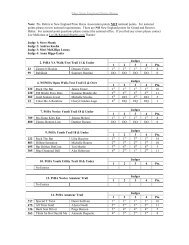2011 Official Rule Book - New England Pinto Horse Association
2011 Official Rule Book - New England Pinto Horse Association
2011 Official Rule Book - New England Pinto Horse Association
Create successful ePaper yourself
Turn your PDF publications into a flip-book with our unique Google optimized e-Paper software.
D. Class Procedure<br />
1. All <strong>Pinto</strong>s competing shall first be lined up at one side<br />
of the arena for instructions from the judge for individual<br />
work.<br />
2. The individual work shall consist of no less than the<br />
following:<br />
a. Separate from the lineup, canter and proceed to jump<br />
two fences.<br />
b. Hand gallop.<br />
c. Stop at a point at least half-way down the long side of<br />
the arena - settle.<br />
d. Back and stand quietly.<br />
e. Return to line up.<br />
3. Scoring<br />
a. 30 percent on performance and manners in the rail<br />
work<br />
b. 30 percent on performance, way of going and manners<br />
on individual work<br />
c. 30 percent on type, conformation, quality and<br />
substance<br />
d. 10 percent on appointments<br />
e. Faults over fences will be scored as in Working Hunter<br />
classes.<br />
f. Only <strong>Pinto</strong>s being considered for an award may be<br />
called back for the rail work.<br />
E. Tack and Attire (See Hunter Seat <strong>Rule</strong> N1).<br />
Q5. Jumping, Pony<br />
A. See Jumper rules for judging fences and courses (except for<br />
heights and distances) and scoring procedures.<br />
B. Distances between in-and-outs shall be the same as for Pony<br />
Hunter Over Fences.<br />
C. Height and Spread – The minimum height for any class in the<br />
first round shall be 2’3”. Classes shall be 2’3” to 2’6” in the<br />
first round and not to exceed 2’9” in subsequent rounds, with<br />
spreads 2’3” to 2’9” (not to exceed 3’3”); 2’6” to 2’9” in first<br />
round (not to exceed 3’0”) with spreads 2’6” to 3’0” (not to<br />
exceed 3’6”); 2’9” to 3’0” in first round (not to exceed 3’3”) with<br />
spreads 3’0” to 3’6” (not to exceed 4’0”). The Show Committee<br />
should take into consideration the size, quality and experience<br />
of Ponies available in determining the height of fences for each<br />
class. The premium list must include height and spread of<br />
fences.<br />
D. Jump-Off – At least 50 percent of the jumps may be raised at<br />
least 3” and not more than 6” in breaking ties when no faults<br />
are involved, and may exceed the maximum allowable height<br />
by 3”. When at least 50 percent of the jumps have been raised<br />
to the maximum height and a tie for first place has not been<br />
broken after the Ponies have jumped the course at this height,<br />
the contenders shall be declared tied.<br />
E. Only Table 1– Touch Classes (Time does not apply in Table 1<br />
classes) may be used in scoring Pony Jumper classes.<br />
Q6. Pony Hunter over Fences<br />
A. See Hunter Over Fences for judging fences and courses<br />
(except for heights and distances).<br />
B. Distances – The suggested distance for in-and-out is 22’ to<br />
24’. If a class is offered as small Pony Hunter and large Pony<br />
Hunter class, the distance for small Ponies (not exceeding<br />
12.2 hands) should be 20’ with 22’ to 24’ for large Ponies (over<br />
12.2, but not exceeding 14.0 hands). The first fence in a Pony<br />
Hunter course must be a vertical fence (i.e., brush or rail).<br />
Oxers and coops are prohibited as a first fence.<br />
C. Height and Spread – The minimum height for any class shall<br />
be 2’3”. The maximum height for any class shall be 3’0”.<br />
<strong>2011</strong> PtHA <strong>Rule</strong> <strong>Book</strong> 175<br />
ClassEs



